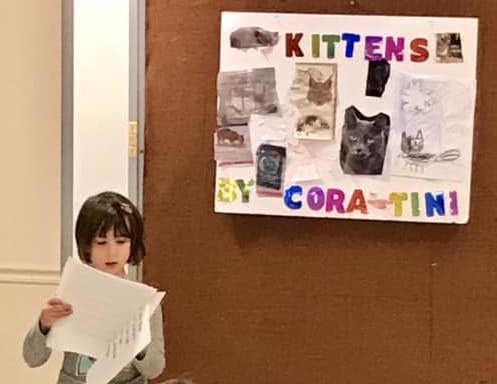Public speaking is cited as one of America’s greatest fears. Yet strong public presentation skills are valued as one of the critical and most desirable strengths in any successful student or professional. How do we overcome our innate fears to develop and practice such valuable skills? As with any skill, public presentation and speaking skills must be taught and practiced. The introduction of these skills to our youngest students allows them to meet the challenge associated with speaking publicly from an early age, instilling children with the increased confidence that leads to success.
At school, a core curriculum that emphasizes public presentation skills teaches that creativity makes for memorable presentations; smooth transitions, the right tone, appropriate presentation speed and length, and body language and eye contact all contribute to an effective presentation; and visual enhancements make a good presentation even better. When public presentations are emphasized in school, even the youngest students acquire improved communication skills, increased self-esteem, planning and preparation experience, and the power of persuasion.
Why take the time to teach public presentation in elementary school? Many students never have to speak to large crowds, it’s true. But lessons in presentation cover so many more skills than those required to “speak to the masses.” Lessons include focused communication skills such as eye contact, tone, volume, speed, inflection, gestures, and the recognition and elimination of nervous tendencies. Required practice is the only opportunity to learn and perfect these skills and to build confidence. Confidence when speaking publicly will also increase a child’s self-esteem and increase the awareness of the power of persuasion.

How do we teach public presentation? The Institute of Public Speaking provides us with some tips. First, a school may want to avoid calling it “public speaking.” The phrase itself may instill fear or carry a negative connotation. Instead, give the activity another name. At my school, we call it the “Good Morning Show” in the younger grades and “Forum” in the middle school. Young students are less likely to be afraid of an activity that sounds like fun! Allow students to have fun exploring a topic of their choice, with few if any limitations.
Next, make presentations a routine part of the core curriculum. Presentations should not be once a year or special events. At my school, students are presenting to multiple grade levels every day, providing all students from kindergarten through grade 8 with opportunities to present publicly three to six times each year.
Then, adopt questioning techniques that ask students to think on their feet as part of the routine activity. At these presentations ask students questions that require them not only to recall, but also to make meaningful connections to something they learned in the past, or something they might have experienced outside of school. Be attentive to Bloom’s Taxonomy (higher order thinking skills), and ensure that these skills are embedded in academic conversations as children become accustomed to open-ended questions requiring them to make connections, predict, apply, etc. Making connections is part of the vernacular at my school – so much so that we have our own hand signal for when a connection is made.
Public speaking techniques have to be taught deliberately and methodically. Teachers start slow and build up, using gradual escalation and frequent practice. At my school, we add required components to presentations, and we do not focus solely on increased duration. As children mature, visuals and enhancements become more defined. Requirements for audience interaction are added. The expectation for the number and types of sources increases.

Finally, teachers provide student with LOTS of precise praise for a job well done. Teachers model a culture of patience and acceptance during presentation times. The focus is never on grades. A grading system may be added only as children enter advanced levels. Teachers work with students on the presentations ahead of time, so on the day of the activity the students are at their best. At my school, we establish a timeline for benchmark submissions, including time for a robust feedback cycle for each component of the presentation. As teachers and students work, the students are encouraged to embrace their creative side and to have FUN! At my school, students are allowed to exhibit their own style as they present. They might make use of music, posters, technology, displays, costumes, live demonstrations and special guests. Teachers demonstrate for students that creativity makes for a memorable presentation. My teachers take time the first week of school to give their own presentations, dressing up in costumes or making videos that feature the staff. Teachers are always encouraging students as they work on and deliver presentations, consistently focusing on the positive.
Schools have many demands on their time as curricular and testing requirements become increasingly complex. But despite our hectic schedules, the inclusion of public presentation skills in our core scope and sequence is a critical component that should not be overlooked. Attention to these skills will reap lifelong benefits that outlast other areas we spend time on throughout the year.
Melissa Earls is Head of School at Academy Hill in Springfield, Massachusetts. She is a graduate of the University of Notre Dame and holds a Master’s Degree in Curriculum and Instructional Leadership from Boston College. Ms. Earls was named a 2019 Head of School Fellow at Columbia University’s Teachers College. For more information, please visit https://www.academyhill.org/welcome or email mearls@academyhill.org.


